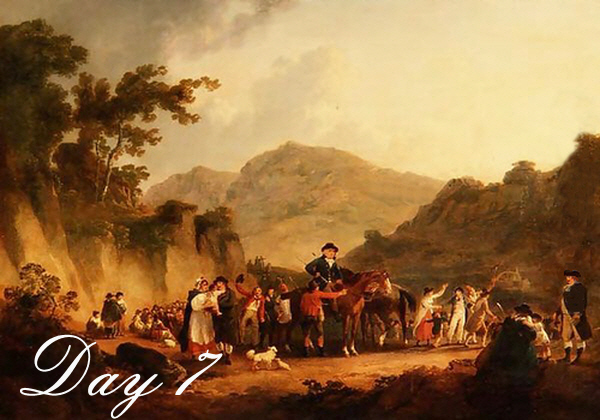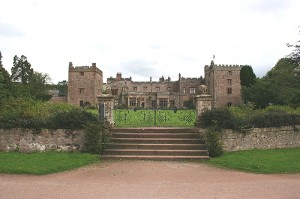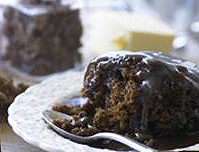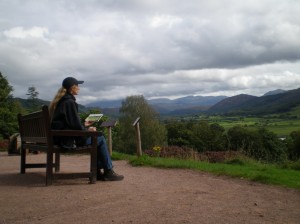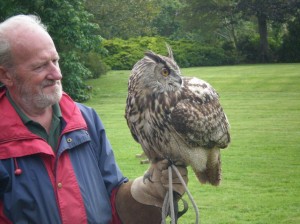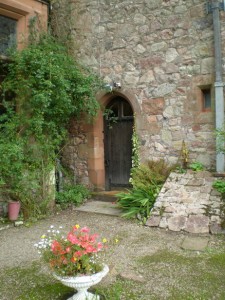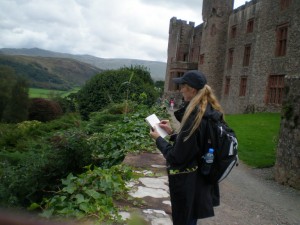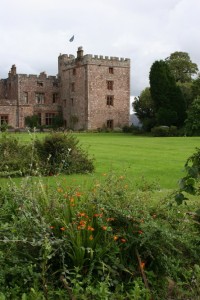Return to: Home > Creative Vision Tours >Great Lakelanders > < Day 6
The last day of our classic tour of the English Lake District, will be spent in remote Eskdale valley in western Lakeland and in particular Muncaster Castle a magnificent fortified manor which has extensive gardens and an owl centre with many different species from around the world.
Situated in lower Eskdale, this impressive fortified house stands on an elevated and commanding position near the mouth of the River Esk with magnificent views of the surrounding mountains. The oldest surviving part of the present structure, a 14th century pele tower to the east of the entrance porch, was built on Roman foundations. The pele-tower and the adjacent hall was the home of the Penningtons for 800 years, a powerful and influential west Cumberland family. In the 16th century the house was extended and in 1780 Sir John Pennington modernized the building. Very little of this work remains as the 4th Lord Muncaster thoroughly remodeled the house in 1860 – 64, engaging the well-known architect, Anthony Salvin. Salvin’s work left the building in its present form. When the direct line of the Pennington family ran out in 1917 Muncaster Castle passed to Sir John Ramsden, the grandfather of the present owner. Sir John introduced works of art to add to the Pennington collection and laid out the gardens, which comprise 70 acres of plants and trees from all over the world and the largest rhododendron collection in Europe.
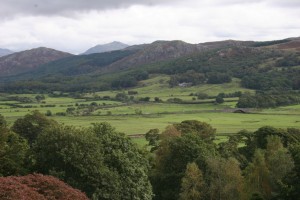 Today the castle is a major tourist attraction for visitors from all over the world who come to see the castle and explore the extensive gardens which contain spectacular rhododendron, camellia and azalea collections, as well as many other rare and unusual trees and plant species. The picturesque quality of these beautiful gardens is also complimented by the dramatic backdrop of the west Lakeland fells which present the visitor with some spectacular views of the mountains around Eskdale.
Today the castle is a major tourist attraction for visitors from all over the world who come to see the castle and explore the extensive gardens which contain spectacular rhododendron, camellia and azalea collections, as well as many other rare and unusual trees and plant species. The picturesque quality of these beautiful gardens is also complimented by the dramatic backdrop of the west Lakeland fells which present the visitor with some spectacular views of the mountains around Eskdale.
The Castle itself houses a large variety of artifacts, collected by the family over the centuries and these treasures include a picture painted by Gainsborough for a bet; John of Bologna’s Alabaster Lady; Henry VI’s drinking bowl, known as the ‘Luck of Muncaster’, dating from his stay at the Castle during the Wars of the Roses; and the most ornamental dinner service the Derby factory ever made. Muncaster Castle is also the headquarters of the World Owl Trust which cares for one of the finest and largest owl collections in the world with over 50 different species including Eagle Owls, Fish Owls and Pygmy Owls which are smaller than a sparrow.
In the afternoon we will board a mini steam train on “La’al Ratty” the affectionate local name for the Ravenglass and Eskdale Light Railway. Described as the most beautiful train journey in England this 15″ Narrow Gauge Railway carries passengers using either miniature steam or diesel engines from the old Roman Port of Ravenglass on the coast, seven miles (11.3 kilometres) into the National Park through hidden Miterdale, to the romantic grandeur of the mountains at the top of the Eskdale valley near Boot village (Dalegarth Station) a complete journey time of around 40 minutes.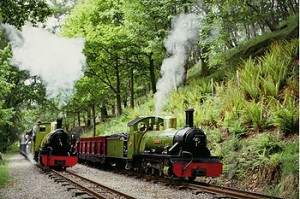 The line originally opened as a 3 foot gauge railway in 1875 to carry granite stone and iron ore from quarries in Eskdale to the junction with another railway at Ravenglass, but fell into disuse when the quarries became depleted 30 years later and it was no longer financially viable. Fortunately for us, after changing the line to a narrow gauge and the involvement of many dedicated steam enthusiasts over the years, this railway today provides the visitor with a unique and extremely scenic perspective of this beautiful valley in West Lakeland. We will travel the full length of the railway to Dalegarth, where we will undertake a short walk up to the spectacular Stanley Ghyll Force a dramatic waterfall within a deep and narrow 60 foot-high gorge with spectacular views looking over the valley. For those less inclined or able to walk this steep path, there is an alternative along the River Esk which is no less impressive or picturesque.
The line originally opened as a 3 foot gauge railway in 1875 to carry granite stone and iron ore from quarries in Eskdale to the junction with another railway at Ravenglass, but fell into disuse when the quarries became depleted 30 years later and it was no longer financially viable. Fortunately for us, after changing the line to a narrow gauge and the involvement of many dedicated steam enthusiasts over the years, this railway today provides the visitor with a unique and extremely scenic perspective of this beautiful valley in West Lakeland. We will travel the full length of the railway to Dalegarth, where we will undertake a short walk up to the spectacular Stanley Ghyll Force a dramatic waterfall within a deep and narrow 60 foot-high gorge with spectacular views looking over the valley. For those less inclined or able to walk this steep path, there is an alternative along the River Esk which is no less impressive or picturesque.
From Eskdale we travel along the Cumbrian coastline southwards to the Victorian country house of Holker Hall. The estate of Holker originally belonged to the Cartmel Priory and Furness Abbey. But during the Dissolution of the Monasteries, the land was granted to the Preston family of Lancashire and later passed by marriage to the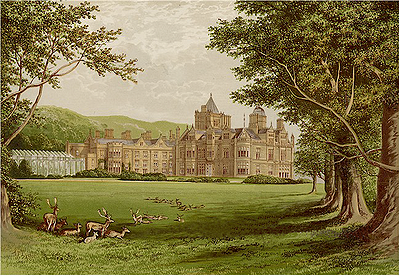 Cavandish family (Dukes of Devonshire) who are the present owners. The Hall was built in the early 17th century but was almost completely rebuilt by the 7th Duke of Devonshire in the mid 19th century. One wing dates from the early years of Queen Victoria’s reign; another wing was built in 1871 after a fire. The interior at Holker Hall is lavishly furnished, with marble fireplaces, splendid linenfold panelling, fine plasterwork and intricate carving. There is a superb oak staircase and Victorian country-house furniture blends with Louis XV pieces. The Long Gallery was designed to recreate an Elizabethan- style gallery. The Drawing Room retains its original silk wall hangings and the Dining Room has a superb carved oak fireplace. The house has several exhibitions including antique kitchen appliances, a photographic display and the Lakeland motor museum. The Lakeland Motor Museum features over 30,000 motoring related exhibits including a 1920s garage re-creation and an exhibition relating to Donald Campbell and his land speed records.
Cavandish family (Dukes of Devonshire) who are the present owners. The Hall was built in the early 17th century but was almost completely rebuilt by the 7th Duke of Devonshire in the mid 19th century. One wing dates from the early years of Queen Victoria’s reign; another wing was built in 1871 after a fire. The interior at Holker Hall is lavishly furnished, with marble fireplaces, splendid linenfold panelling, fine plasterwork and intricate carving. There is a superb oak staircase and Victorian country-house furniture blends with Louis XV pieces. The Long Gallery was designed to recreate an Elizabethan- style gallery. The Drawing Room retains its original silk wall hangings and the Dining Room has a superb carved oak fireplace. The house has several exhibitions including antique kitchen appliances, a photographic display and the Lakeland motor museum. The Lakeland Motor Museum features over 30,000 motoring related exhibits including a 1920s garage re-creation and an exhibition relating to Donald Campbell and his land speed records.
Holker Hall is renowned for it’s truly spectacular gardens, which extend to over 25-acre (100,000 m2) and are a mix of formal and informal elements, containg an arboretum, mixed herbaceous borders a Victorian rockery and a late 20th century cascade. The garden houses the National Collection of styracaceae and in 1991 the gardens at Holker won the Historic Houses Association as Garden of the Year Award and in 2002, Holker’s Great Lime, which probably dates from the early 17th century, was selected as one of Britain’s 50 Great Trees in honour of Queen Elizabeth II’s Golden Jubilee.
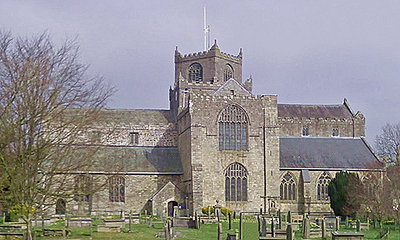 We finish our day by a visit to the picturesque valley of the River Eea and the pretty village of Cartmel. At the centre of the village is Cartmel Priory, which was founded as an Augustinian Priory in 1189 by William Marshall, Baron of Cartmel, later created Earl of Pembroke and appointed Regent of England during the minority of Henry III. The building served as a grammer school from 1624 to 1790 and today is the parish church and is notable for incorporating the three great periods of English eccliastical architecture: Transitional Norman (1190-1250) Decorated (1320-1350) and Perpendicular (1400-1450).. The former gatehouse of the Priory forms an archway over one of the village streets and contains a small museum on the history of Cartmel. Before we leave the village we’ll take a late afternoon tea and sample some of Cartmel’s very own local delicacy “Sticky Toffee Pudding”
We finish our day by a visit to the picturesque valley of the River Eea and the pretty village of Cartmel. At the centre of the village is Cartmel Priory, which was founded as an Augustinian Priory in 1189 by William Marshall, Baron of Cartmel, later created Earl of Pembroke and appointed Regent of England during the minority of Henry III. The building served as a grammer school from 1624 to 1790 and today is the parish church and is notable for incorporating the three great periods of English eccliastical architecture: Transitional Norman (1190-1250) Decorated (1320-1350) and Perpendicular (1400-1450).. The former gatehouse of the Priory forms an archway over one of the village streets and contains a small museum on the history of Cartmel. Before we leave the village we’ll take a late afternoon tea and sample some of Cartmel’s very own local delicacy “Sticky Toffee Pudding”
Highlights:
- Muncaster Castle- antiquities, castle, owl centre and gardens, also a painting by Gainsborough.
- World Owl Trust
- Eskdale Light Railway
- Ravenglass
- Stanley Ghyll Force waterfall
- Views in the Eskdale valley – photos from Google of Eskdale Valley.
- Views of Langdales
In addition to transportation to all of the destinations stated above as well as bed/breakfast and evening meal on each day, the tour price includes travel from and return to either Newcastle airport, Newcastle ferry port or Newcastle Railway Station, depending on passengers requested pick up and dropping off point, and from where the tour shall begin and finish. Although Old School Tours will endeavour to satisy requests for alternative pick up and dropping off points, this must be agreed in advance a minimum of 21 days prior to the start of the tour.
Please Contact Us for any questions or to reserve your space on this fantastic tour!
Please enjoy these photos taken by Mary while staying at Muncaster Castle for a sketching tour:





